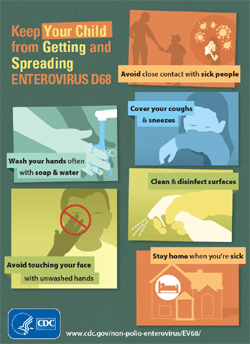Strep Throat - Tonsillitis (Strep Pharyngitis)
What is strep pharyngitis?
Strep pharyngitis is a highly contagious bacterial infection caused by a Group A Strep (GAS) bacteria. It is sometimes referred to as tonsillitis or strep throat. Group A streptococcus is a bacterium often found in the throat and on the skin. People may carry group A streptococci in the throat or on the skin and have no symptoms of illness. Most GAS infections are relatively mild illnesses such as "strep throat," or impetigo. On rare occasions, these bacteria can cause other severe and even life-threatening diseases.
Gastroenteritis & Noroviruses
What is gastroenteritis?
The symptoms of gastroenteritis are nausea, vomiting, and/or diarrhea accompanied by abdominal cramps. Some people also complain of headache, fever, chills and muscle aches. Symptoms are usually brief and last only one or two days. However, during that period, people can feel very ill and vomit, often violently and without warning, many times a day. Symptoms usually begin 24 to 48 hours after ingestion of the virus, but can appear as early as 12 hours after exposure.
School Vaccination Coverage Data
Updated: Oct. 14, 2025
Tuberculosis Testing
DPH provides tuberculosis screening only for TB suspects/cases, and contacts to a TB case.
Tuberculosis Contact Us
DPH Tuberculosis Control Section
Phone: (803) 898-0558
Fax: (803) 898-0685
TB Section Director
Amy Painter, RN, BSN
State TB Medical Consultant
Dr. F. Richard Ervin
Nurse Consultants
Candace Solomon, MSN, RN
Kendra Walker, MSN, RN
Program Administrator
Katie Waites, MPH
Surveillance Coordinator
Yolanda Jacobs
Health Educator
Morgan Seganti, MPH, CHES
Flu Surveillance Components and Definitions
Learn More About The Flu
Treating the Flu
There are prescription medicines called antiviral drugs that can be used to treat influenza illness. These medicines can help prevent serious flu complications (like pneumonia). For more information about antiviral drugs visit cdc.gov/flu/treatment/antiviral-drugs.
High Risk Groups
High-Risk Groups for Flu
Most people who get the flu will have mild illness and will recover in less than two weeks. Some people with certain medical conditions (like heart or lung disease) or certain age groups (including children younger than 5 years and adults 65 years and older) are at high risk for developing flu-related complications (like pneumonia). Flu-related complications can be serious and lead to hospital stays or even death.


